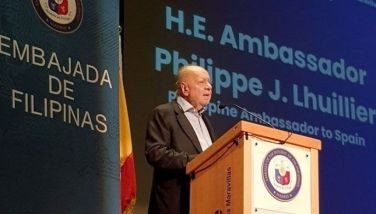More from Singapore
My deepest sympathies, first of all, to the victims of tropical storm Ondoy, whose wrath we barely escaped. We drove out that fateful Saturday morning to have my bronchitis looked at the Lung Center, and by the time we left the hospital, the whole area around the Quezon Memorial Circle had turned into a churning lake. We plowed through the water and snuck out to the higher ground of UP Village just in time; another 15 minutes would have made a terrible difference. I spent the rest of the week coughing and wheezing like a neglected Volkswagen, but it takes a disaster like Ondoy to remind us how trivial our complaints and rants are, compared to what many of our countrymen have to endure — with or without typhoons.
* * *
Lest I completely forget, let me attend this week to a few more interesting details I noted from a recent visit to Singapore. I’d wanted to report on these very shortly after that visit, but more pressing concerns like the National Artist Awards controversy came into the picture.
During that trip, I was privileged to judge a competition to which young Singaporeans — most of them in high school — submitted their own short stories. I read over 150 entries over a few days before choosing the three winners and citing five other meritorious pieces on the shortlist. One thing that left a deep impression on me was how many of the stories I read (certainly more than half) had to do with the death and loss of mothers — many of whom are taken for granted by the protagonists, who then undergo deep remorse. I’ll leave it to the sociologists and psychoanalysts to puzzle that one over, but it was such a salient feature that I thought I’d take note of it.
I also observed how many of the people we met in Singapore were fellow Filipinos, and how well they did in their jobs: Sherwin on the river boat cruise, Marby in one of the quayside restaurants, Tere in the specialist shoe store. They do us and their families proud, keeping our heads above another kind of deluge, and I keep hoping that when they come home, they’ll bring with them the higher expectations that will turn this country around toward a more just and modern society.
* * *
And now, as I do once every once in a while, I’m going to turn over the rest of this piece to Beng’s own impressions of Singapore, specifically her visit to its Heritage Conservation Centre, to which she had been invited by a friend and fellow conservator, Ricky Francisco of the Lopez Museum, who’s training with the HCC. Beng (also known as June Poticar Dalisay) is, of course, an art restorer and conservator, and keenly interested in learning new and advanced conservation techniques from the best of the world and of the region. It was her first trip to Singapore, and while I was busy with my own functions at the literary festival, Beng hied off with Ricky to the HCC for a day with their peers. She reports:
“HCC is a government-funded institution whose primary task is to preserve, conserve, and maintain the art collections and all acquisitions of all government museums. I was so glad that the director of the HCC approved Ricky’s request to show me around the center.
“I was introduced to Ang Jee, a quiet but talented conservator, who gave me a tour of the storage rooms, which were huge and had very high ceilings to accommodate big and tall artworks. I noticed that vinyl tiles covered the floor, laid out just like hospital floors, without seams or corners, to prevent the accumulation of dirt and for easy cleaning. Small boxes to trap insects were strategically placed on the floor near the doors, which were lined at the bottom with plastic bristles to filter the air that passes through the gap between door and floor and to prevent insects from entering.
“I was then shown a room where paintings are stored. It was a very spacious area that held a sizeable number of artworks from different Asian countries, including several oil paintings done by Filipino painters. The paintings hung from panels and glided smoothly along tracks laid out on the floor. This room and the other room for storing huge and tall items were equipped with temperature and humidity controls. Video cameras are strategically located not only in these rooms but along corridors as well.
“Ricky led me to a conference room where I was introduced to Heng Noi Loh, director of the HCC. Though slight of built, this lady impressed me with her energy, dedication and vision for the future of the Centre. We discussed common problems experienced by art conservators all over. Heng Noi was very interested in our Art Conservation and Restoration Services Inc. (ACES), today the biggest private art conservation company in the Philippines, which I helped to establish with six other Filipino colleagues in 2001. I was informed that Singapore does not have any similar company. Ricky, on the other hand, shared his experience in organizing a forum (which I attended) where art conservators/restorers, museum curators, art historians, art critics came together to discuss problems and concerns that affect the practice in the Philippines.
“‘And what is the most serious problem of Filipino conservators?’ Heng Noi asked. I told her that our government does not seem to give enough priority and seriousness in preserving our history and culture. Government institutions and museums need more financial support to modernize conservation laboratories. We also need to include art conservation as a certificate or degree course in universities and colleges. The Philippines has very skilled conservators, but the existing laboratories and equipment are not at par with our neighbors in Asia. Singapore and Thailand are far ahead of the Philippines since these countries recognize the importance of protecting their culture and heritage, a valuable asset that also contributes to the economy. Heng Noi and I ended our meeting with an agreement to continue to communicate with each other.
“Singapore is basically a young country but it has taken every step to preserve not only its artifacts, but also its old districts lined with quaint and colorful shop-houses. I was really impressed with the Singapore’s efforts to revive and bring to life the river that meanders gracefully through the city. Butch and I had a wonderful time exploring Chinatown and Little India where we saw the blending of the old Singapore with the new and modern structures around the city.
“My visit to the HCC gave me the opportunity to meet and observe conservators of different nationalities as they went about their work. I felt such envy as I looked around the modern and very well equipped laboratories. I told myself that this should and will serve as an inspiration for me and for my country to aim for the best.
“My tour of the HCC was almost over but before I left, I was able to join the center’s conservators — Amanda, Cheryl, Mar, Selina and Ricky — in discussing the treatment for a painting on paper. We were so engrossed in this activity that we forgot about our differences, our race, our age, our color. And for one moment, we were one, united by our desire to save a piece of history — Singapore’s history, our friend, our neighbor.”
* * *
E-mail me at penmanila@yahoo.com, and visit my blog at www.penmanila.net.



















